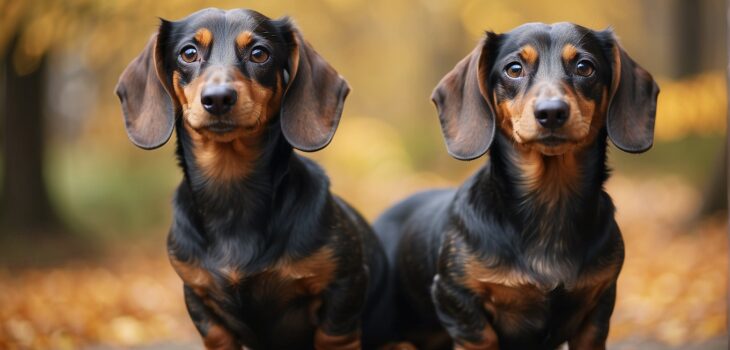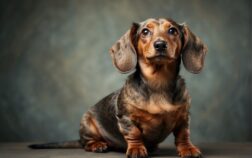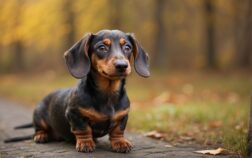If you’re looking for a four-legged companion that is as unique as they are adorable, look no further than the lovable Dachshund. These pint-sized pups are known for their distinctive long bodies, short legs, and expressive personalities, making them stand out from the crowd. From their fearless nature to their unwavering loyalty, Dachshunds have a special charm that captivates dog lovers everywhere. So, let’s explore what sets these delightful canines apart and discover why they hold such a special place in the hearts of many.
Physical Characteristics
Long and low body
Dachshunds, also known as sausage dogs, are characterized by their distinctive long and low body shape. Their elongated body is one of their most recognizable features and sets them apart from other dog breeds. This unique physique is caused by their genetic makeup and is a result of their breeding history.
Short legs
In addition to their long body, Dachshunds also have short legs that contribute to their adorable appearance. These stubby limbs are a defining characteristic of the breed and are perfectly proportioned for their body length. Despite their short legs, Dachshunds are surprisingly agile and can move with surprising speed.
Long snout
Another notable physical characteristic of Dachshunds is their long snout. This elongated muzzle allows them to have a heightened sense of smell, which is a trait that has been retained from their hunting days. Their acute sense of smell makes them excellent scent trackers, which was one of their primary purposes when they were originally bred.

Elongated ears
Dachshunds are also known for their expressive, elongated ears. These floppy ears hang down from the sides of their heads, adding to their charming and friendly appearance. Their long ears not only enhance their cuteness but also serve a practical purpose by capturing scents in the air and directing them towards their keen sense of smell.
Expressive eyes
Dachshunds have eyes that are full of expression and intelligence. Their large, soulful eyes are one of their most endearing features, often described as being like “pools of love.” The intensity in their eyes reflects their loyal and affectionate nature, making them wonderful companions and family pets.
History and Origin
German origin
Dachshunds have a rich history that can be traced back to Germany. The breed was developed in the early 17th century, originally bred to hunt badgers and other burrow-dwelling animals. The word “Dachshund” itself comes from the German words “Dachs” meaning badger, and “Hund” meaning dog, literally translating to “badger dog.”
Originally bred for hunting badgers
As their name suggests, Dachshunds were specifically bred for hunting badgers. Their unique body shape, characterized by their long and low stature, enabled them to easily maneuver through burrows and tunnels. Equipped with their sharp sense of smell and courageous nature, Dachshunds excelled at locating and flushing out badgers from their underground dens.

Developed in the 17th century
The development of Dachshunds as a distinct breed can be attributed to German breeders in the 17th century. These breeders selectively crossed various types of hounds and terriers to create a dog with the perfect combination of body shape, intelligence, and hunting instinct. Over time, the breed was refined to achieve the characteristics that we see in Dachshunds today.
Registered by the American Kennel Club in 1885
Dachshunds made their way to the United States in the late 19th century and gained popularity among dog enthusiasts. Recognizing their unique qualities, the American Kennel Club (AKC) registered the Dachshund breed in 1885, solidifying their status as a recognized and beloved breed in the country.
Distinctive Coat Types
Smooth coat
Dachshunds come in three distinctive coat types, one of which is the smooth coat. Smooth-coated Dachshunds have a sleek and shiny coat that lies close to their body. This short and dense coat requires minimal grooming and sheds less compared to other coat types. Despite its simplicity, the smooth coat adds a touch of elegance to the Dachshund’s overall appearance.
Wirehaired coat
Another coat type commonly found in Dachshunds is the wirehaired coat. This coat is characterized by a more rugged and dense texture, consisting of a combination of soft and coarse fur. Wirehaired Dachshunds have a distinct beard and eyebrows, giving them a charming and distinguished look. This coat type requires regular hand-stripping or professional grooming to maintain its appearance.
Longhaired coat
Dachshunds with longhaired coats possess a luxurious and flowing coat that adds another layer of charm to their already adorable appearance. Their long and silky fur typically requires regular brushing and grooming to prevent tangles and mats. While this coat type may require more maintenance compared to the smooth or wirehaired varieties, the longhaired Dachshund’s coat is undeniably beautiful and exudes elegance.
Different grooming needs for each type
Each coat type requires specific grooming needs. Smooth-coated Dachshunds only need occasional brushing to remove loose hair, while wirehaired Dachshunds may require professional grooming to maintain their coat’s texture and shape. Longhaired Dachshunds, on the other hand, need regular brushing and grooming to keep their fur looking its best. Understanding and attending to the grooming needs of each coat type will help keep your Dachshund looking and feeling its best.
Archetypal Sausage Dog
Nicknamed as ‘sausage dogs’
Dachshunds earned the endearing nickname “sausage dogs” due to their long, cylindrical shape resembling a sausage or hot dog. This nickname perfectly captures the essence of their unique physique and has become widely recognized and loved by Dachshund enthusiasts all over the world.
Their body shape resembles a sausage or hot dog
The archetypal Dachshund is characterized by its elongated body and short legs, closely resembling the shape of a sausage or hot dog. This unique body shape is what sets Dachshunds apart from other breeds and adds to their overall charm and appeal.
Adorable and unique silhouette
The silhouette of a Dachshund is undeniably adorable and instantly recognizable. Their long and low body, coupled with their short legs, elongated ears, and expressive eyes, creates a visual appeal that is hard to resist. Whether in motion or at rest, Dachshunds exude an irresistible charm that makes them stand out among other dog breeds.
Different color variations
Dachshunds come in a wide array of color variations, adding even more diversity and uniqueness to their overall appearance. Common coat colors include red, black and tan, chocolate and tan, and dapple, which is a marbled pattern. Their coat colors, combined with their distinctive body shape, make Dachshunds even more visually striking and captivating.
Temperament
Lively and playful
Dachshunds possess a lively and playful temperament that makes them a delight to be around. They have an innate sense of curiosity and enthusiasm that ensures there is never a dull moment when you have a Dachshund by your side. Their playful nature also makes them wonderful companions for families with children and other pets.
Loyal and affectionate
Dachshunds are known for their loyalty and strong bond with their families. They have an unwavering devotion to their owners and enjoy being in close proximity to them. Dachshunds thrive on affection and crave love and attention, making them excellent companions for those seeking a loyal and affectionate canine companion.
Can be stubborn at times
Despite their endearing qualities, Dachshunds can also be stubborn at times. This stubbornness is a reflection of their independent nature, which can present challenges when it comes to training. Patience and consistency are key when training a Dachshund, as they require gentle persuasion and positive reinforcement to encourage cooperation.
Protective of their families
Dachshunds may be small in size, but they have a big heart and a strong protective instinct towards their families. They are known to be courageous and will not hesitate to alert their owners to potential threats or intruders. This protective nature, combined with their loyalty, makes Dachshunds excellent watchdogs, despite their seemingly unassuming appearance.
Tendency to be wary of strangers
Dachshunds can be wary of strangers, displaying a natural inclination to be cautious around unfamiliar faces. This wariness towards strangers is rooted in their protective instincts and is a trait that has been inherited from their hunting ancestry. Proper socialization from an early age can help minimize any potential timidity or aggression towards strangers.
May exhibit boldness and curiosity
Although Dachshunds can be a bit wary of strangers, they often make up for it with their boldness and curiosity. They possess a fearless nature that compels them to explore their surroundings and investigate new scents and sounds. Dachshunds’ natural curiosity adds a touch of adventure and excitement to their personalities, making them entertaining and engaging companions.
Natural Hunting Instincts
Originally bred for hunting badgers and other burrow-dwelling animals
Dachshunds have a strong hunting background and were originally bred to hunt badgers and other burrow-dwelling animals. Their unique physical characteristics, such as their long body and short legs, were specifically developed to help them excel in this pursuit. While their hunting roles have diminished over time, these instincts are still deeply ingrained in their DNA.
Retain strong scent tracking abilities
Dachshunds retain their strong scent tracking abilities, which are a testament to their hunting heritage. Their acute sense of smell allows them to follow scents with precision and determination. This trait can manifest in various ways, such as tracking interesting scents during walks or engaging in play activities that tap into their scent tracking abilities.
May display a tendency to dig and chase small prey
Due to their hunting instincts, Dachshunds may display a tendency to dig and chase small prey. Their desire to explore and uncover hidden treasures is often driven by their innate hunting drive. Providing appropriate outlets for their digging and chasing instincts, such as puzzle toys or supervised play sessions, can help satisfy these natural inclinations without causing damage or harm.
May require mental and physical stimulation to channel their instincts
To prevent boredom and ensure a well-rounded and fulfilled Dachshund, it is important to provide them with both mental and physical stimulation. Engaging in activities that challenge their problem-solving skills, such as puzzle toys or obedience training exercises, can help keep their minds sharp. Additionally, regular exercise and playtime are crucial for channeling their energy and satisfying their hunting instincts in a safe and controlled environment.
Prone to Certain Health Conditions
Intervertebral disc disease
Dachshunds are genetically predisposed to intervertebral disc disease (IVDD), a condition that affects their spinal discs. The long and low body shape of Dachshunds puts extra strain on their spines, increasing the risk of disc degeneration and potential disc herniation. This is a serious condition that may require medical intervention or even surgery, so it is important to be vigilant and take steps to prevent injury.
Obesity and related issues
Dachshunds have a tendency to gain weight if not provided with a balanced diet and regular exercise. Obesity can lead to a variety of health issues, including joint problems, heart disease, and a shortened lifespan. Maintaining a healthy weight through proper nutrition and portion control, combined with regular exercise, can help prevent obesity-related issues.
Orthopedic problems
As mentioned earlier, Dachshunds’ elongated bodies and short legs can put them at an increased risk of orthopedic problems. Conditions such as hip dysplasia, patellar luxation, and arthritis may be more prevalent in this breed. Providing a supportive and comfortable living environment, regular exercise, and access to ramps or stairs can help minimize the strain on their joints and reduce the risk of orthopedic issues.
Eye diseases
Certain eye diseases, such as progressive retinal atrophy (PRA) and cataracts, can occur in Dachshunds. Regular eye examinations by a veterinarian can help detect any signs of eye disease early on and prevent further deterioration of vision. Additionally, providing a healthy diet rich in essential nutrients and antioxidants can support overall eye health.
Diabetes
Dachshunds are also prone to developing diabetes, especially if they are overweight or have a poor diet. Regular veterinary check-ups and monitoring your Dachshund’s weight and blood glucose levels are crucial for early detection and management of diabetes. Maintaining a balanced diet, incorporating regular exercise, and managing weight are important factors in preventing or managing this condition.
Regular veterinary check-ups and a balanced diet are important
To ensure the overall health and well-being of your Dachshund, regular veterinary check-ups are essential. These check-ups allow for early detection of any potential health issues and timely intervention. Additionally, providing a balanced and nutritious diet that meets their specific dietary requirements will help keep them in optimal health throughout their lifespan.
Socialization and Training
Importance of early socialization
Early socialization is crucial for Dachshunds to help them develop into well-rounded and socially confident dogs. Introducing them to various people, animals, environments, and experiences at a young age helps them build positive associations and reduce the chances of fear or aggression later in life. Enrolling in puppy socialization classes or seeking guidance from professional trainers can greatly facilitate this process.
Can be stubborn and require patient training
Dachshunds are known for their independent and stubborn nature, which can pose challenges when it comes to training. Patience, consistency, and positive reinforcement-based training methods are key to successfully training a Dachshund. Harsh or punitive training methods are not recommended and can lead to resistance and mistrust. Keeping training sessions short, engaging, and fun will help maintain their focus and eagerness to learn.
Positive reinforcement based training methods
Dachshunds respond best to positive reinforcement-based training methods, which involve rewarding desired behaviors with treats, praise, or play. This encourages them to repeat the behavior and reinforces the bond between the owner and the dog. Motivating them with rewards and using clear and consistent cues during training sessions will enable effective communication and foster a harmonious relationship between you and your Dachshund.
Good candidates for obedience and agility training
Due to their intelligence and agility, Dachshunds are excellent candidates for obedience and agility training. These activities not only provide mental stimulation but also help channel their energy in a productive and positive way. Participating in obedience and agility training not only strengthens the bond between you and your Dachshund but also builds their confidence and enhances their overall well-being.
Lifespan and Size
Average lifespan of 12-15 years
Dachshunds have a relatively long lifespan compared to other dog breeds, with an average lifespan of 12 to 15 years. However, it is important to note that individual Dachshunds may vary, and factors such as genetics, lifestyle, and healthcare can impact their longevity. Regular veterinary care, a balanced diet, and providing a safe and enriching environment can contribute to maximizing their lifespan.
Varying sizes: standard, miniature, and toy
Dachshunds come in different sizes, with the standard size being the most common. Standard Dachshunds typically weigh between 16 and 32 pounds and stand about 8 to 9 inches tall at the shoulder. Miniature Dachshunds are smaller, weighing between 11 and 16 pounds and standing about 5 to 6 inches tall. Toy Dachshunds are the smallest variety, weighing under 11 pounds and standing about 4 to 5 inches tall.
Different sizes have specific exercise and care needs
Each size of Dachshund has specific exercise and care needs. Standard Dachshunds require moderate exercise to keep them physically and mentally stimulated. Miniature and toy Dachshunds may have slightly lower exercise requirements but still benefit from regular activity and mental stimulation. It is important to tailor their exercise routine to their size to prevent overexertion or insufficient exercise.
Popular Celebrity Dachshund Owners
Pablo Picasso
The legendary artist Pablo Picasso was known to be a proud owner of a Dachshund named Lump. Lump was not only a beloved companion to Picasso but also served as a source of inspiration for some of his artworks, including paintings and ceramics.
Einstein
Einstein, the world-renowned physicist, had a deep love for Dachshunds and was frequently seen in the company of his furry companions. He considered his Dachshunds, named Chico and Yuki, as his loyal and affectionate companions throughout his life.
David Hockney
David Hockney, the influential British artist, is another famous Dachshund owner. He had a long-standing fondness for the breed and often included his beloved Dachshunds, Stanley and Boodgie, in his paintings and other artworks.
Napoleon Bonaparte
Even the historical figure Napoleon Bonaparte had a soft spot for Dachshunds. He owned a Dachshund named Odie, who accompanied him on various military campaigns and was known for his loyalty and companionship.
Johnny Knoxville
Johnny Knoxville, the American actor and stunt performer, is a proud owner of a Dachshund named Rocko. Knoxville often shares pictures and stories about Rocko, showcasing the affection and love he has for his furry friend.
In conclusion, Dachshunds are truly unique and remarkable dogs. From their distinctive physical characteristics and rich history to their playful temperament, natural hunting instincts, and susceptibility to certain health conditions, Dachshunds are a breed worthy of admiration and care. Whether they are beloved family pets or the companions of famous individuals, Dachshunds continue to capture the hearts of many with their charming looks and lovable personalities.




